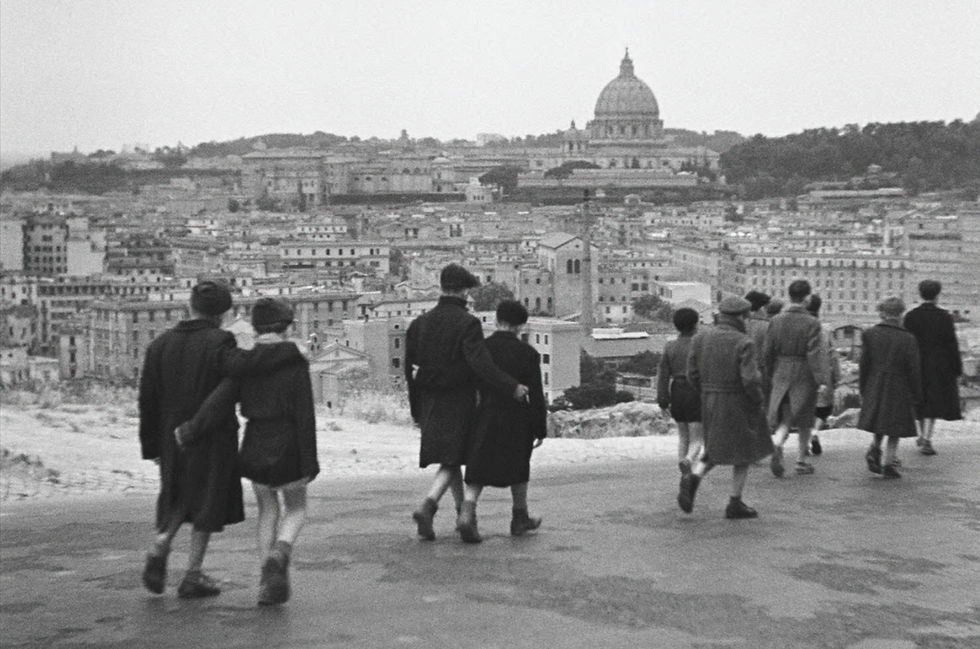Film Movements Series: Italian Neorealism
- Sergiu Inizian

- Oct 31, 2021
- 4 min read
Updated: Sep 11, 2024

The subject of “Italian Neorealism” is considered a continuation of the series “Film Movements”. It is recommended to first read the introductory article which takes a look at German Expressionism, while also presenting the scope and methodology of the series.
Italian Neorealism refers to a collection of films developed between 1943 and 1952, which tell the story of a war-torn psyche and society. As the name implies, these Italian filmmakers presented the unfiltered reality of post-war Europe, through heartbreaking narratives of poverty, oppression, and desperation. The movement highlighted the need for raw images in times of strife and its naturalistic approach left a greatly influential mark on cinema.
Context
This movement came as a reaction to World War II and the fascist censors of the past years. However, it also meant a rebuilding of cinematic consciousness, after the fall of Mussolini brought the industry to the ground. As with most Western European countries at the time, without a national cinema, the U.S. dominated the market. However, as “domestic companies struggled, Neorealist cinema emerged as a force for cultural renewal and social change” (Thompson & Bordwell, 2002, p. 359).
This realist and activist movement did not appear in a vacuum. It acted as a companion to what would be later called the Italian Spring. After the war, in 1945, parties “formed a coalition government, aiming to make left-liberal ideas the basis of a reborn Italy” (Thompson & Bordwell, 2002, p. 360). By 1948, as the country started its ascendance to modernity and prosperity, this movement started disappearing. However, Neorealist films survived and even thrived during this period. Moreover, the realist sensibilities of these filmmakers found a new audience as the industry “discovered that it could export films, even to the United States” (Thompson & Bordwell, 2002, p. 361).
Characteristics
During the years in which it produced its most significant works, the movement was somewhat separated. In the year after, critics, filmmakers, and journalists tried to compile a set of core concepts and technical aspects which linked Neorealist cineastes. One treatment focused on the political aspect of the movement, referring to the style as “committed reportage, calling for reform in the name of political unity” (Thompson & Bordwell, 2002, p. 362).
Another critical reading pinpointed the universality of the stories and argued that the films would offer a personal narrative of general moral significance. This concept of treating the objective reality through a subjective lens would later have worldwide cinematic influence, from France to Romania and Mexico. A third analysis, which focused on the documentary style of the films, argued that the impact of such films came from its distinctive eye for the simple beauty of ordinary life.

From a stylistic point of view, these films present elements which would later become synonymous with cinematic realism: amateur actors, on-location scenes, and seemingly indifferent framing. With these components, these filmmakers would construct naturalistic scenes which seemed to reflect “the chance encounters of daily life” (Thompson & Bordwell, 2002, p. 363).
Some critics and journalists argue that the movement represents the first expression of modernist cinema. The slice-of-life approach constituted an impactful departure from classical plot-driven movies and influenced later naturalistic filmmakers both technically and conceptually. One technique, which is now popular even with mainstream cineastes is the unfiltered long take. This style acted as a fitting vessel for the loose narratives of Neorealist films and presented the events “in continuous real time, without the manipulations of editing” (Thompson & Bordwell, 2002, p. 357).
Key Films
Probably the most important film for the movement, Rome, Open City (1945) takes an unfiltered look at the horrors of World War II. Roberto Rossellini’s film focuses on the story of an Italian resistance leader during the Nazi occupation of Rome in 1944 and depicts the lives of oppressed citizens with startling frankness.
The film thrives through naturalistic acting and an intimate cinematic eye that presents hardship not to shock the spectator but to shine a light on the reality of a devastated city. However, behind the startling images, Rossellini seems to briefly show signs of hope. His images of spirituality and resistance are chosen “not only [to] reconstruct Italy’s recent past under Fascism but also its potential future” (Isaacs, 2019).

Vittorio De Sica’s Bicycle Thieves (1948) is probably one of the simplest, yet most impactful films of its period. The narrative focuses on a father and a son, who are searching for the man’s stolen bicycle, which is essential for his work. The almost documentary-like camera movements and the background compositions make up for one of the most gripping exercises in cinematic realism.
Moreover, the genuine connection between the two creates a naturalistic, relatable narrative that keeps the spectator constantly engaged. At the same time, the futility of their search and the constant uncertainty presented in the background paint one of the most convincing images of “the brutal rapacity of postwar life” (Thompson & Bordwell, 2002, p. 361).
Another Rossellini film, Germany, Year Zero (1948), presents the struggles of a young German boy in post-war Berlin. The film’s strength lies in the unforgettable images of devastated buildings which backdrop the protagonist’s internal strife. This constant dialogue between the internal and the external came out of Rossellini’s ambition to present “not just a city and a population reduced to chaos but a terrain leveled spiritually and morally” (Rosenbaum, 2010).
The film is to this day a masterful example of a cinematic tragedy. Its frankness, unfiltered framing, and characters are sure to have a tremendous impact on any spectator, regardless of prior knowledge of the movement.
An aesthetic born from a desolate but resourceful state of mind, Neorealism not only represents a search for cinematic reality, but also a search for truth. In these films, the camera follows its characters to reveal genuine feelings and thoughts, while at the same time painting the very real image of devastation. This realist sensibility, combined with the use of long shots and amateur actors would later influence generations of filmmakers across all genres and nationalities.
References:
Thompson, K., & Bordwell, D. (2002). Film History: An Introduction (2nd ed.). McGraw-Hill Humanities/Social Sciences/Languages.
Isaacs, B. (2019, February 3). The great movie scenes: Rome, Open City - fascism, tragedy and the birth of Italian neo-realism. The Conversation. https://theconversation.com/the-great-movie-scenes-rome-open-city-fascism-tragedy-and-the-birth-of-italian-neo-realism-110771
Rosenbaum, J. (2010, January 25). Germany Year Zero: The Humanity of the Defeated. Criterion. https://www.criterion.com/current/posts/1358-germany-year-zero-the-humanity-of-the-defeated







https://www.epsxf.com ; https://www.yyeps.com; https://epsxf.com; https://yyeps.com; https://eps-machine.net; https://epp-machine.com; https://eptu-machine.com; https://eps-machine.top; https://epp-eptu-machine.com; https://sw-eps.com; EPS Machine EPS Cutting Machine; EPP MachineEps Raw Material; EPS MachineEPS Mould; EPP MachineEPS Recycling System; EPS MachineEPS Block Molding Machine; EPP MachineEPS Shape Moulding Machine; EPP MachineAging Silo for EPS Machine; EPS Machine; ETPU MachineEPS and EPP Heating Room; ETPU Machine; ETPU MachineAging Silo for EPS Machine; EPP Machine; EPP Machine EPP Shape Moulding Machine; EPS MachineEPS and EPP Heating Room